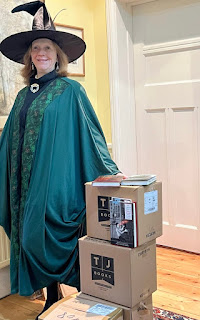Editing, by Elizabeth Kay
The days of reliable editors in publishing houses and
magazines are long gone. Although many of them are still excellent, the changes
in English teaching here in Great Britain over the decades have taken their
toll. I notice far more mistakes in professionally-published books than I ever
did forty years ago. And if you’re considering the self-publishing route, you
need to be your own editor which is very hard work. Always remember that
writing is about communicating; if you cannot express yourself adequately,
without waffling, you won’t achieve the impact you want.
In the commercial world, word-count
is very important. Magazines have specific slots to fill, and children’s books
may be part of a series with a house style that doesn’t vary. Competitions will
have a maximum word-lengths for short stories, and if you run over you’ll be
disqualified.
It is always possible to cut,
even if it doesn’t feel like it. Honestly.
For the first pass, look at ways
of eliminating repetitions, condensing what you say, and cutting out
unnecessary adjectives and adverbs. It’s surprising how much you can get rid of
this way.
For the second pass, look at the
order in which you present information. Would it be more economical to do it
another way? Do you have any superfluous characters? If they’re necessary for
furthering the plot, can you combine two of them? Do you really need that scene
– what does it achieve? Try justifying each sentence to yourself out loud, and
asking yourself whether it furthers the plot, develops the characters, and
illustrates the theme. Not every scene can do all these things, but it’s
something to aim for.
The third pass is the most
difficult, and really applies to longer pieces such as books or plays. This is
when you still need to get rid of a lot of words, and you have to decide to get
rid of a plot thread. It’s a bit like unravelling knitting – when you knit it
back together, you must remember to pick up all the stitches. I know I’ve read
plenty of books when I suddenly think – whatever happened to X? It’s almost
certainly because the book has been edited, and a plot thread hadn’t been
extracted all the way back. Now that we have word processors, and search
facilities that can hunt out such things it’s much easier to do than
previously.
Sometimes it seems as though
you’ve edited out important moments to ensure the piece doesn’t over-run. This
kind of thing is an integral part of being a professional writer. I have often
been required to drastically cut a manuscript – usually because I’ve decided to
aim it at a different target. My book for reluctant readers, Fury,
was originally a full-length book
for adults and started life at 75,000 words. My agent suggested that, as the
main protagonist was a teenage girl, I should cut it to 40,000 and aim it at a
different market. When this didn’t sell we re-thought it once more, aimed it at
reluctant readers and cut it to 9,000, whereupon it was published by Barrington
Stoke. I realized that as the main protagonist was a teenager, it might work
better for a younger age-group, so it went from 70,000 words to 40,000. This
didn’t work as well as I’d hoped, and my agent suggested I cut it still further
for a different readership. So it went down to 9,000 words, and was published
by Barrington Stoke. Now that it’s out of print I’ve re-done it for the Kindle,
and this time I can illustrate it myself. It also means re-doing the cover, of
course, so that I don’t infringe the copyright of the original cover designer. So now there's the UK cover, the American one, and my Kindle version. The whole process of doing such a drastic edit was really interesting. You
start by getting rid of everything that isn’t vital, and you condense wherever
you can. But that’s not enough for a cut this drastic, so plotlines have to go
as well. It’s rather like trying to unpick a piece of knitting or embroidery.
If you don’t follow the thread all the way back to the beginning you’re left
with a question – what happened to the man in the top hat? Where did the horse
go? What was the result of the drought? I think we’ve all read books where
something has gone unanswered, and neither the writer nor the editor has
spotted the problem. It’s an easy error to commit, but it may stop the suspension
of disbelief because it’s reminding the reader that this story is a fabrication
– it only ever happened in the mind of the writer, not real life.
The whole process of doing such a drastic edit was really interesting. You
start by getting rid of everything that isn’t vital, and you condense wherever
you can. But that’s not enough for a cut this drastic, so plotlines have to go
as well. It’s rather like trying to unpick a piece of knitting or embroidery.
If you don’t follow the thread all the way back to the beginning you’re left
with a question – what happened to the man in the top hat? Where did the horse
go? What was the result of the drought? I think we’ve all read books where
something has gone unanswered, and neither the writer nor the editor has
spotted the problem. It’s an easy error to commit, but it may stop the suspension
of disbelief because it’s reminding the reader that this story is a fabrication
– it only ever happened in the mind of the writer, not real life.
Don’t be afraid of cutting. All
things are possible!





Comments